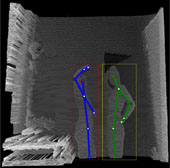Event Based Transcription System for Polyphonic Piano Music
Giovanni Costantini, Massimiliano Todisco, Renzo Perfetti
 Music transcription consists in transforming the musical content of audio data into a symbolic representation. The objective of this study is to investigate a transcription system for polyphonic piano, triggered by events corresponding to the played notes. The proposed method focuses on note events and their main characteristics: the attack instant, the pitch and the final instant. Onset detection exploits a binary time-frequency representation of the audio signal. Note classification and offset detection are based on constant Q transform (CQT) and support vector machines (SVMs). We present a collection of experiments using synthesized MIDI files and piano recordings, and compare the results with existing approaches.
Music transcription consists in transforming the musical content of audio data into a symbolic representation. The objective of this study is to investigate a transcription system for polyphonic piano, triggered by events corresponding to the played notes. The proposed method focuses on note events and their main characteristics: the attack instant, the pitch and the final instant. Onset detection exploits a binary time-frequency representation of the audio signal. Note classification and offset detection are based on constant Q transform (CQT) and support vector machines (SVMs). We present a collection of experiments using synthesized MIDI files and piano recordings, and compare the results with existing approaches.
Texture Granular Synth 3.2
Giorgio Nottoli, Giovanni Costantini, Michelangelo Nottoli, Andrea Angelini, Massimiliano Todisco
 Texture is an instrument to perform Asyncronous Granular Synthesis based upon the algorithm developed by Giorgio Nottoli [Conservatorio di Santa Cecilia, Roma], and is fully implemented with programming language C++. It generates a grains’ flow in which the way each grain follows the other depends on probabilistic parameters such as grain density (attack/sec), overlapping, synchronism and fade of each grain. The spectrum generated by the synthesis could be harmonic, expanded or contracted according to the value of frequency exponent parameter; the result will be a sound texture that can change from noisy fragmented sounds, to metallic and tuneless sounds such as bells, finally to harmonic sounds similar to strings or choirs.
Texture is an instrument to perform Asyncronous Granular Synthesis based upon the algorithm developed by Giorgio Nottoli [Conservatorio di Santa Cecilia, Roma], and is fully implemented with programming language C++. It generates a grains’ flow in which the way each grain follows the other depends on probabilistic parameters such as grain density (attack/sec), overlapping, synchronism and fade of each grain. The spectrum generated by the synthesis could be harmonic, expanded or contracted according to the value of frequency exponent parameter; the result will be a sound texture that can change from noisy fragmented sounds, to metallic and tuneless sounds such as bells, finally to harmonic sounds similar to strings or choirs.
RandyMa
Luigi Marino, Giovanni Costantini
 RandyMa is a tool oriented to real time performance realized in MaxMSP with the add of some new externals developed in C. It offers a whole range of possibilities, spacing from real time buffer recording and management, basic granular synthesis, complex algorithmic techniques, FX bank and mixer. RandyMa is composed by three patches which can be used singularly too: MBR, Randy, and a mixer. In the page Musical Research you can find some examples of interactive music, tape music, and installations realized by this tool.
RandyMa is a tool oriented to real time performance realized in MaxMSP with the add of some new externals developed in C. It offers a whole range of possibilities, spacing from real time buffer recording and management, basic granular synthesis, complex algorithmic techniques, FX bank and mixer. RandyMa is composed by three patches which can be used singularly too: MBR, Randy, and a mixer. In the page Musical Research you can find some examples of interactive music, tape music, and installations realized by this tool.
A Neural Network Based Interface to Expressively Control Musical Processe
Giovanni Costantini, Massimiliano Todisco
We develop an innovative Neural Network system interface that allows an electronic music composer to plan and conduct the musical expressivity of a performer. For musical expressivity we mean all those execution techniques and modalities that a performer has to follow in order to satisfy common musical aesthetics, as well as the desiderata of the composer. The proposed interface is able to transform two input parameters in many sound synthesis parameters. Especially, we focus our attention on mapping strategies based on Neural Network to solve the problem of electronic music expressivity.
Interfacce per il controllo espressivo di processi musicali (in Italian)
Giovanni Costantini, Massimiliano Todisco
Con il termine ‘processo musicale’ si intende un complesso algoritmo di sintesi/elaborazione del suono sul quale sia possibile un controllo ad alto livello. Tale controllo deve essere effettuato ‘in tempo reale’, cioè mentre si ascolta il suono prodotto dal processo stesso. Essendo molto spesso coinvolti un gran numero di parametri di sintesi/elaborazione, è necessario utilizzare interfacce di controllo che consentano di guidarli tutti contemporaneamente in modo semplice ed espressivo dal punto di vista musicale.
Tali interfacce sono realizzate mediante sensori di vario tipo (microfoni, videocamere, sensori a pressione, a flessione, piezoelettrici, ecc…) e possono inglobare sistemi complessi di mapping come reti neurali.
Objective Speech Intelligibility Measures for Forensic Applications
Giovanni Costantini, Andrea Paoloni, Massimiliano Todisco
In the context of forensic phonetics, the transcription of intercepted signals is particularly important. However, these signals are often degraded and the transcript may not reflect what was actually pronounced. In the absence of the original signal, the only way to see the level of accuracy that can be obtained in the transcription of difficult material is to develop an objective methodology for intelligibility measurements. This study has been using a corpus specially built to simulate the real conditions of forensic signals. With reference to this corpus, a measurement system of intelligibility based on STI (Speech Transmission Index) has been evaluated. The result of the experiment shows a high correlation between objective measurements and subjective evaluations. Therefore it is recommended to use the proposed methodology in order to establish whether a given intercepted signal can be transcribed with sufficient reliability.






















